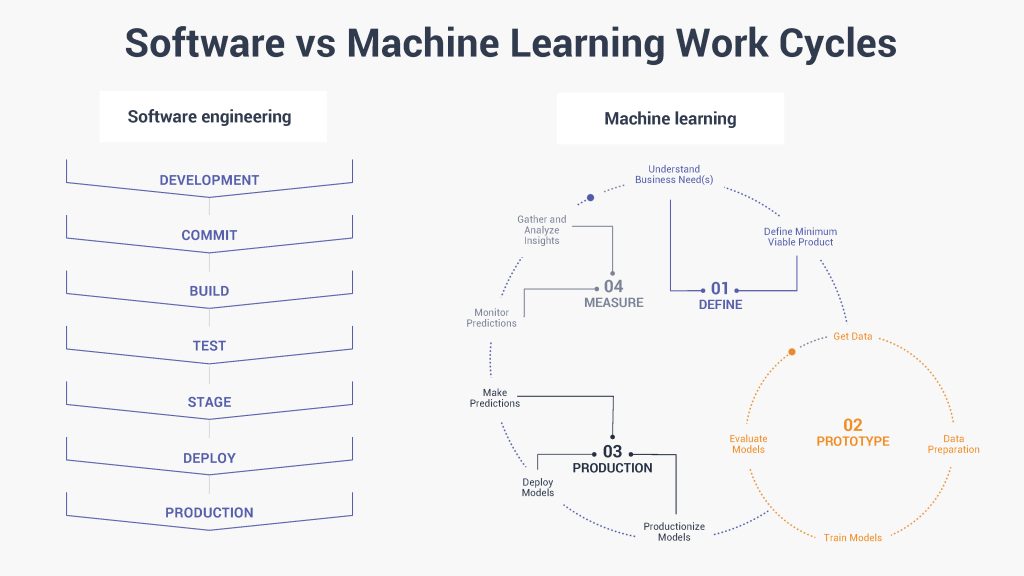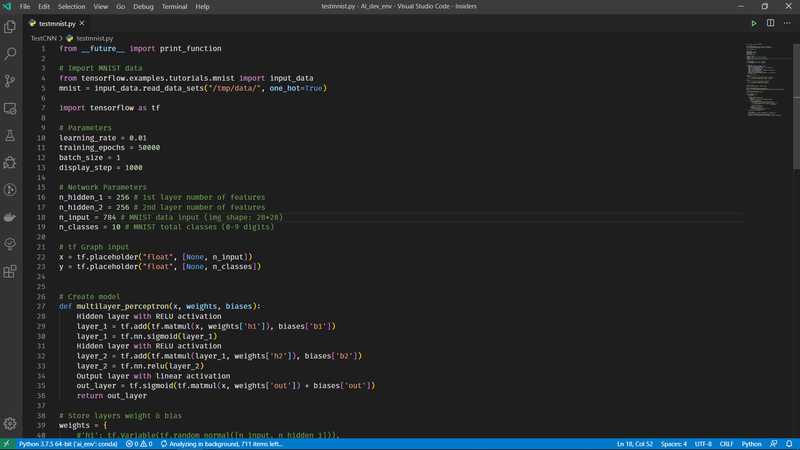All Categories
Featured
Table of Contents
- – Some Of Machine Learning Applied To Code Devel...
- – The Buzz on Machine Learning Is Still Too Hard...
- – The Single Strategy To Use For Machine Learni...
- – How How I Went From Software Development To M...
- – Little Known Facts About Ai Engineer Vs. Sof...
- – The Definitive Guide to What Does A Machine ...
- – How What Does A Machine Learning Engineer Do...
Some people believe that that's unfaithful. Well, that's my entire profession. If somebody else did it, I'm mosting likely to use what that person did. The lesson is putting that apart. I'm requiring myself to believe with the feasible services. It's more regarding consuming the web content and attempting to apply those concepts and much less concerning finding a library that does the job or finding someone else that coded it.
Dig a little bit deeper in the math at the beginning, just so I can build that foundation. Santiago: Finally, lesson number 7. I do not think that you have to understand the nuts and bolts of every algorithm prior to you use it.
I've been using neural networks for the longest time. I do have a sense of how the gradient descent functions. I can not explain it to you right currently. I would have to go and inspect back to really get a better intuition. That doesn't indicate that I can not address points using neural networks? (29:05) Santiago: Trying to require individuals to assume "Well, you're not mosting likely to be effective unless you can describe every solitary detail of how this functions." It returns to our sorting instance I think that's simply bullshit suggestions.
As an engineer, I've serviced many, numerous systems and I have actually made use of numerous, numerous things that I do not comprehend the nuts and screws of how it functions, despite the fact that I recognize the influence that they have. That's the last lesson on that string. Alexey: The funny point is when I think concerning all these libraries like Scikit-Learn the formulas they make use of inside to apply, as an example, logistic regression or something else, are not the very same as the algorithms we study in artificial intelligence classes.
Some Of Machine Learning Applied To Code Development
Also if we tried to discover to obtain all these essentials of equipment knowing, at the end, the formulas that these libraries make use of are various. Santiago: Yeah, definitely. I believe we require a lot more materialism in the industry.

Incidentally, there are two different courses. I generally speak with those that want to function in the industry that wish to have their influence there. There is a course for researchers which is totally various. I do not risk to discuss that due to the fact that I don't understand.
Yet right there outside, in the market, pragmatism goes a lengthy method without a doubt. (32:13) Alexey: We had a comment that stated "Really feels even more like inspirational speech than discussing transitioning." So perhaps we ought to switch. (32:40) Santiago: There you go, yeah. (32:48) Alexey: It is a great motivational speech.
The Buzz on Machine Learning Is Still Too Hard For Software Engineers
One of the points I desired to ask you. First, allow's cover a pair of points. Alexey: Let's begin with core tools and frameworks that you need to learn to actually shift.
I recognize Java. I understand SQL. I know how to utilize Git. I know Bash. Perhaps I know Docker. All these things. And I become aware of equipment discovering, it appears like a great point. What are the core devices and structures? Yes, I saw this video clip and I obtain convinced that I don't need to obtain deep right into mathematics.
What are the core tools and frameworks that I require to find out to do this? (33:10) Santiago: Yeah, absolutely. Terrific concern. I believe, number one, you need to start learning a little bit of Python. Since you currently recognize Java, I don't think it's mosting likely to be a big transition for you.
Not because Python coincides as Java, but in a week, you're gon na get a great deal of the differences there. You're gon na have the ability to make some development. That's primary. (33:47) Santiago: After that you obtain specific core devices that are going to be used throughout your entire job.
The Single Strategy To Use For Machine Learning Developer
You obtain SciKit Learn for the collection of equipment learning formulas. Those are devices that you're going to have to be using. I do not advise just going and learning concerning them out of the blue.
Take one of those programs that are going to begin introducing you to some problems and to some core concepts of equipment understanding. I don't bear in mind the name, however if you go to Kaggle, they have tutorials there for complimentary.
What's great regarding it is that the only demand for you is to understand Python. They're going to present an issue and inform you how to make use of decision trees to address that particular issue. I believe that procedure is incredibly powerful, due to the fact that you go from no machine learning history, to recognizing what the trouble is and why you can not solve it with what you know now, which is straight software application engineering practices.
How How I Went From Software Development To Machine ... can Save You Time, Stress, and Money.
On the other hand, ML engineers concentrate on building and releasing artificial intelligence versions. They concentrate on training designs with information to make forecasts or automate jobs. While there is overlap, AI engineers deal with even more diverse AI applications, while ML engineers have a narrower emphasis on artificial intelligence formulas and their useful implementation.

Device understanding engineers focus on establishing and deploying equipment understanding models right into manufacturing systems. They service engineering, making certain models are scalable, efficient, and integrated into applications. On the other hand, information scientists have a more comprehensive role that includes data collection, cleansing, expedition, and building models. They are frequently liable for drawing out understandings and making data-driven decisions.
As companies progressively take on AI and maker discovering innovations, the need for proficient professionals grows. Equipment learning designers deal with cutting-edge tasks, add to advancement, and have affordable incomes. However, success in this area calls for continuous knowing and staying up to date with progressing innovations and strategies. Machine learning roles are typically well-paid, with the capacity for high earning potential.
ML is basically different from traditional software growth as it concentrates on teaching computers to learn from information, instead than shows specific regulations that are performed systematically. Uncertainty of end results: You are probably made use of to composing code with foreseeable results, whether your function runs as soon as or a thousand times. In ML, nonetheless, the end results are much less specific.

Pre-training and fine-tuning: Just how these models are trained on substantial datasets and then fine-tuned for particular tasks. Applications of LLMs: Such as text generation, sentiment evaluation and info search and access. Papers like "Interest is All You Required" by Vaswani et al., which presented transformers. On the internet tutorials and courses focusing on NLP and transformers, such as the Hugging Face program on transformers.
Little Known Facts About Ai Engineer Vs. Software Engineer - Jellyfish.
The capability to take care of codebases, combine modifications, and settle conflicts is equally as essential in ML advancement as it is in standard software application jobs. The abilities established in debugging and screening software program applications are very transferable. While the context might change from debugging application reasoning to identifying problems in information handling or version training the underlying principles of organized examination, hypothesis screening, and repetitive refinement coincide.
Device learning, at its core, is greatly dependent on stats and chance theory. These are essential for recognizing exactly how formulas gain from information, make forecasts, and examine their performance. You should consider becoming comfy with ideas like statistical relevance, circulations, theory testing, and Bayesian thinking in order to design and translate designs efficiently.
For those interested in LLMs, a comprehensive understanding of deep knowing architectures is useful. This includes not just the auto mechanics of neural networks however also the style of details versions for different use situations, like CNNs (Convolutional Neural Networks) for photo processing and RNNs (Recurring Neural Networks) and transformers for sequential information and all-natural language handling.
You should know these issues and find out strategies for determining, alleviating, and communicating about bias in ML designs. This consists of the prospective influence of automated choices and the moral effects. Lots of designs, particularly LLMs, call for considerable computational sources that are typically offered by cloud platforms like AWS, Google Cloud, and Azure.
Structure these skills will certainly not just promote an effective shift right into ML however likewise ensure that designers can contribute effectively and responsibly to the advancement of this dynamic area. Theory is essential, but absolutely nothing defeats hands-on experience. Start working with jobs that permit you to use what you've discovered in a functional context.
Develop your tasks: Begin with straightforward applications, such as a chatbot or a message summarization device, and gradually raise intricacy. The field of ML and LLMs is quickly evolving, with brand-new innovations and innovations emerging frequently.
The Definitive Guide to What Does A Machine Learning Engineer Do?
Sign up with communities and online forums, such as Reddit's r/MachineLearning or area Slack networks, to discuss concepts and obtain recommendations. Attend workshops, meetups, and conferences to get in touch with various other specialists in the field. Add to open-source projects or write blog site posts about your discovering trip and tasks. As you get expertise, start searching for possibilities to include ML and LLMs right into your work, or look for new roles concentrated on these technologies.

Possible usage cases in interactive software, such as referral systems and automated decision-making. Comprehending unpredictability, standard statistical steps, and chance distributions. Vectors, matrices, and their role in ML algorithms. Mistake minimization strategies and slope descent described simply. Terms like model, dataset, functions, tags, training, reasoning, and recognition. Information collection, preprocessing techniques, model training, evaluation procedures, and release considerations.
Choice Trees and Random Woodlands: User-friendly and interpretable models. Matching problem types with proper versions. Feedforward Networks, Convolutional Neural Networks (CNNs), Recurring Neural Networks (RNNs).
Constant Integration/Continuous Release (CI/CD) for ML process. Version tracking, versioning, and efficiency monitoring. Spotting and resolving adjustments in design performance over time.
How What Does A Machine Learning Engineer Do? can Save You Time, Stress, and Money.

You'll be introduced to 3 of the most pertinent parts of the AI/ML technique; supervised knowing, neural networks, and deep knowing. You'll realize the differences between standard shows and equipment learning by hands-on advancement in monitored understanding before building out complicated distributed applications with neural networks.
This training course functions as a guide to maker lear ... Show Extra.
Table of Contents
- – Some Of Machine Learning Applied To Code Devel...
- – The Buzz on Machine Learning Is Still Too Hard...
- – The Single Strategy To Use For Machine Learni...
- – How How I Went From Software Development To M...
- – Little Known Facts About Ai Engineer Vs. Sof...
- – The Definitive Guide to What Does A Machine ...
- – How What Does A Machine Learning Engineer Do...
Latest Posts
How To Practice Coding Interviews For Free – Best Resources
How To Get Free Faang Interview Coaching & Mentorship
How To Overcome Coding Interview Anxiety & Perform Under Pressure
More
Latest Posts
How To Practice Coding Interviews For Free – Best Resources
How To Get Free Faang Interview Coaching & Mentorship
How To Overcome Coding Interview Anxiety & Perform Under Pressure